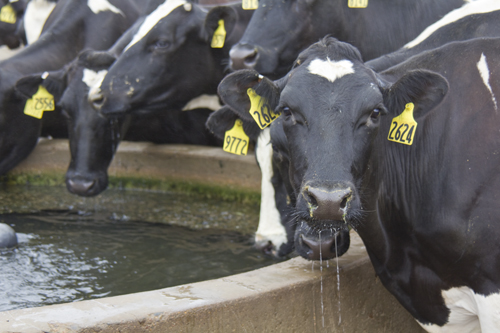
by Amanda Smith, Hoard's Dairyman Associate Editor
Water, according to David Beede, with the Department of Animal Science at Michigan State University, is the most essential nutrient for cows. At the 2012 Cornell Nutrition Conference, Beede shared 12 take homes to improve the quality of water on your dairy.
- Abundant, high-quality water is the most important nutrient for cows. If either water quality or quantity is a problem, then nutritionists may struggle to deliver expertise to their clients.
- Are quantity and quality bottlenecks to maximum health and performance?
Producers and their consultants can rarely answer these two questions for the initial assessment of water quality adequacy on their farms:- How much are cattle in particular groups drinking?
- What is the quality of that water?
- Based on a large water quality study with over 3,600 samples, between 15 and 30 percent of samples exceeded the upper level for calcium, sodium and sulfate. Over 40 percent of samples exceeded desired levels of iron and manganese.
- After analyzing over 200 suspect water samples, the most common quality problems were high iron and high anion (sulfate and chloride) concentrations. These may negatively impact cow performance.
- The only way to know if water has excess iron or anion concentrations (sulfate and chloride greater than 500 parts per million) is to have samples analyzed.
- Sampling procedures can be found here.
- Treatments are available to remove excess nutrients from water. Chlorination with filtration, ion exchange, ozonation, reverse osmosis and oxidizing filters can be used but costs vary.
- If water quality problems exist, the challenge is to find a new water source or an effective treatment system.
- When looking at systems, be sure to tell vendors how much water will need to be treated. Approximately 50 gallons per cow per day is a reasonable estimate but may not account for all of your needs.
- When quality isn't an issue, the most common problem are inadequate numbers of watering stations, space at waterers or waterers that don't fill fast enough to allow cows to meet their needs.
- Lack of adequate water can also be linked to overstocking.
- Future dairy viability will depend on more efficient use if water is to maximize performance and health, while optimizing use to reduce your farm's water footprint.








